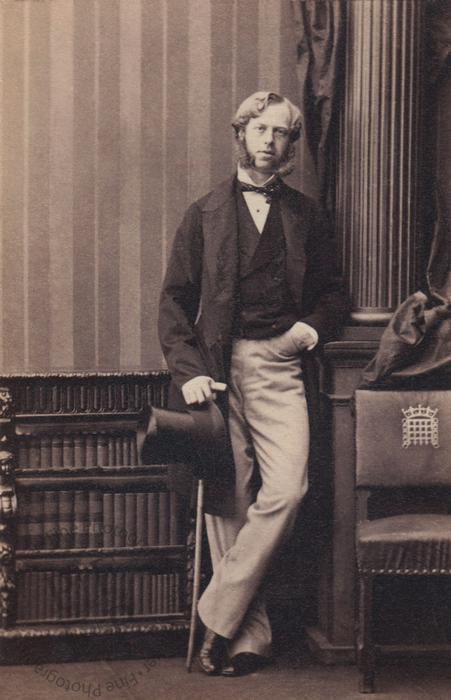John William Ramsden, MP
(1831-1914)
26 June 1861
Volume 4, page 134, sitting number 4608.
Born on 14 September 1841, John William Ramsden, known as ‘Jack’ to his family, was the second but only surviving son of the Whig and Liberal politician John Charles Ramsden of Newby Park in Yorkshire. His mother was Isabella née Dundas, youngest daughter of Thomas Dundas, 1st Baron Dundas of Aske.
His father died when he was five years old and he inherited his baronetcy from his grandfather when he was seven, becoming the 5th Baronet of Byram; he also inherited two estates in Yorkshire and most of the town of Huddersfield. In addition, he owned 11,248 acres of the West Riding as well as 800 acres of Lincolnshire and a 138,000 acre estate near Inverness.
Following his education at Eton and at Trinity College, Cambridge, he entered politics and during his long career represented various constituencies in Parliament. He sat as the Member of Parliament for Taunton from 1853 to 1859, for Hythe from 1857 to 1859, for the West Riding of Yorkshire from 1859 to 1865, for Monmouth from 1868 to 1874, for the East Riding of Yorkshire from 1880 to 1885, and finally for Osgoldcross in Yorkshire from 1885 to 1886. He stood as the Liberal Unionist candidate for Osgoldcross in 1886 but was defeated. He was also briefly, from 1857 to 1858, the Under Secretary of State for War.
According to one history of the Ramsden family, John William Ramsden was a brilliant business man who ‘doubled his fortune by converting a failed Malayan sugar plantation into a hugely successful rubber plantation’ (Poverty is Relative, Meriel Buxton, 2017).
On 2 August 1865 he married Lady Helen Guendolen Seymour, youngest daughter of Edward Adolphus Seymour, 12th Duke of Somerset, thus also acquiring the Bulstrode estate at Gerrards Cross. The marriage produced four children, including a son who became the 6th Baronet.
In 1901 he was living at Byrom Hall in Yorkshire with his wife and an unmarried daughter. Also present on the night of the census were 23 servants, including a butler, four footmen, a coachman and a groom, with various gardeners and a gamekeeper living nearby.
John Wililim Ramsden died, aged 82, on 15 April 1914 at Bulstrode, Gerrards Cross, after an illness of about ten days. He left an estate valued at £489,028.
According to an obituary in the Hull Daily Mail (16 April 1914), ‘Boon companions were Sir John Ramsden, the late Lord Londesborough, and the late Mr Christopher Sykes. The trio had certain physical attributes of size and complexion. Like his predecessors Sir John William Ramsden drew a handsome revenue from Huddersfield (the greater part of which he owned), chiefly in the form of ground rents. He had the reputation of being a man of immense wealth – his income was some years ago put at £168,000 a year – but there are those who say he was not as rich as many people imagined. […] The estate, it is said, has been subject to many heavy charges, and it is an open secret that Sir John lost an enormous sum over certain speculations abroad some years ago. He had four country houses – Byram, Ferrybridge; Longly, Huddersfield; Bulstrode, Bucks; and Ardverikie, Kingussie, N.B.’
[His portrait is shown here opposite a portrait of his first cousin Frederick Dundas, whose father the Honourable Charles Lawrence Dundas was one of the brothers of John William Ramsden’s mother, Isabella.]

